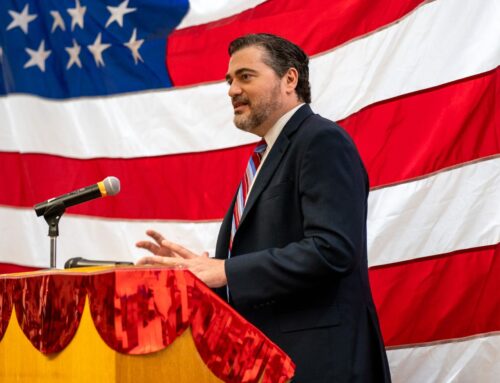By Donald J. Hayden, Miami Herald| May 31, 2019
Pedestrians walk past the Cuban Telephone Company in 1996. The company had been run by International Telephone and Telegraph Co., but nationalized by the Cuban government in 1960. This and thousands of other American-owned properties nationalized 36 years ago, including more than 100 being used by foreign firms in partnerships with Cuba, have long been ignored in the political battle between Cuba and the United States. The Helms-Burton Act changed that.
With much fanfare, the Trump administration announced in April that it was allowing U.S. citizens to file lawsuits against both Cuban government-owned entities and companies that are either in possession of properties that were seized by the Cuban government following the 1959 Cuban Revolution, or are “trafficking” in, that is, deriving economic benefit from those seized properties. For over 23 years, every other presidential administration steered clear of implementing Title III, the provision of the Helms-Burton Act that allows for such lawsuits both out of concerns that it would wreak havoc for multinational corporations of many of the U.S.’s leading trading partners, particularly the European Union and Canada, and it would congest the federal courts with tens of thousands of reparation claims by Cuban-Americans whose properties were seized by the Castro regime.
Experts have widely speculated on how many lawsuits could arise from this “about-face” change in policy. The U.S. Department of State has estimated that up to 200,000 claims reaching a value of over $8 billion could result, given that over 95 percent of property on the island was expropriated by the Castro regime and given the Cuban diaspora, particularly to South Florida when Castro came to power.
Now that Title III claims can be brought, multinationals both here in the U.S. and abroad need to evaluate their exposure. This holds true especially for multinationals based in Canada and in certain European Union partners, which have invested significantly for many years in Cuba. Spanish companies, given Spain’s close ties with Cuba since colonial times, are particularly vulnerable. However, there are a number of exemptions, blocking laws and other obstacles to any speedy recovery through Title III litigation that could prove to make the above State Department estimates significantly inflated.
Although we have no crystal ball, it is probably best to predict who has exposure by discussing the different types of claims that could be made and what hurdles might still be in place that will impact any windfall recovery for claimants in the short term. The different claims and factors at play are being closely evaluated by both companies with exposure due to their Cuban investments, and the plaintiff’s bar.
The first bucket of claims consists of those claims by U.S. citizens or companies who,back in 1959, owned Cuban properties expropriated by the Cuban government. Those claims called “certified” claims have been recognized by the Foreign Claims Settlement Commission (FCSC).
On May 2, the first date for filing of Title III lawsuits, Exxon Oil filed a significant claim in federal court in Washington, D.C., against the Republic of Cuba for its expropriation of oil refineries that its predecessor, Standard Oil, had owned before the regime change. Judgments against the Cuban government or Cuban-owned companies are unlikely to be satisfied in the short term unless the litigants can find Cuban assets located in the United States.
Finding available Cuban assets in the U.S. is not without precedent. In the mid-1990s, plaintiffs found the blocked accounts held by my client, AT&T, and one other telecom provider for services provided by the Cuban telephone company over the course of several decades. Those accounts were used to entirely satisfy an approximately $200 million default judgment against the Republic of Cuba for the shooting down of pilots in the “Brothers to the Rescue” lawsuit here in Miami. However, at this point, there has been no indication that today’s litigants would be so lucky as to find significant Cuban assets in the United States.
The second bucket of claims consists of those claims by Cuban-Americans, primarilylocated in South Florida, whose property was expropriated at or around the time that they migrated to the United States. These lawsuits could involve foreign companies that have joint-ventured with Cuban-owned companies, taken ownership of properties that were expropriated by the Cuban government originally, or have derived some benefit from the use of the expropriated properties.
A Carnival Cruise ship is docked at the PortMiami as the company becomes one of the first to be sued under Title III of the Helms-Burton Act at the Wilkie D. Ferguson Jr. U.S. Courthouse on May 02, 2019 in Miami. The lawsuit filed by Javier Garcia-Bengochea and Mickael Behn claim they are the owners of confiscated property in Cuba and are among the first to file lawsuits against European and American companies doing business on their former properties after the Trump Administration announced that they will allow Title III of the Helms-Burton Act to go into effect.
The widely publicized Carnival cruise line lawsuits also filed on May 2 fall into that category. A Cuban-American family claims ownership to a large swath of the Havana port and seeks reparations for Carnival’s use of those port facilities.
We can anticipate more lawsuits like the above against cruise lines, hotel chains, and airlines like Aeroméxico that have provided service to Cuba for decades as well as U.S. airlines like American, Delta and Jet Blue, who more recently provided services after the Obama administration’s attempt to normalize relations with Cuba. Although Title III has express exemptions for “travel services” and “technology,” the Carnival lawsuits signal that the savvy plaintiff’s bar will test the expanse of those exemptions, especially given the upside of treble damages available under the Act.
The third bucket and most viable claims involve claims against foreign multinationals that have assets here in the U.S. and that have significantly invested in Cuba for some time. Canadian, European Union, and more recently, Chinese companies have significant investments in Cuba. Canada and the European Union have blocking statutes to protect assets in their home jurisdictions from being exposed to U.S. judgments under Title III.
China in general has never recognized a U.S. judgment for purposes of attaching assets located there. However, given our global economy, many of the vulnerable foreign multinational companies have assets here in the U.S.. For example, the Mélia hotel chain, a large Spanish conglomerate, has assets throughout the U.S. as well as had hotel operations for many years in Cuba. At present, you can expect that considerable time and effort is being focused on determining whether foreign companies investing in Cuba have available assets here in the U.S. to satisfy large treble damage judgments in Title III lawsuits.
Besides claims against those in the travel and hospitality sectors, you can expect Title III lawsuits against those who have invested in Cuban mining, infrastructure, real estate, technology, and luxury goods (e.g., rum and cigars). Given the dramatic change in policy in allowing for these lawsuits to proceed, companies investing in Cuba need to, at the very least, re-evaluate their exposure to Title III lawsuits going forward.
 Donald J. Hayden is a partner at Mark Migdal & Hayden. He is a commercial litigator who specializes in commercial cross-border disputes and international arbitration. He was lead counsel for AT&T in the supplementary proceedings to attach the Cuban government assets held by AT&T in blocked accounts in the “Brothers to the Rescue” litigation of the mid 1990’s.
Donald J. Hayden is a partner at Mark Migdal & Hayden. He is a commercial litigator who specializes in commercial cross-border disputes and international arbitration. He was lead counsel for AT&T in the supplementary proceedings to attach the Cuban government assets held by AT&T in blocked accounts in the “Brothers to the Rescue” litigation of the mid 1990’s.



